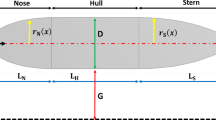Abstract
The air layer drag reduction (ALDR) of an axisymmetric body in oscillatory motions is investigated in this paper with open source toolbox OpenFOAM. The unsteady Reynolds-averaged Navier-Stokes (URANS) equations are used to determine the viscous flow and the volume of fluid (VOF) model is adopted to capture the interface of the air-water two-phase flow. The k − ε turbulence model is adopted to simulate the turbulence. The dynamic mesh technique is applied to model the movement of the axisymmetric body. Firstly, the ALDR results are validated by the experimental data. Then, the effects of the movements of the body on the drag reduction during the ALDR state are investigated. Two representative kinds of movements are considered, namely, the pitch and the heave. The numerical results show that the drag reduction varies during the movements and the average drag reduction rates will be reduced. The variation of the drag reduction is related to the morphological change of the air layer. The heave motion is more likely to reduce the effects of the ALDR than the pitch motion. For both oscillatory motions, the large motion amplitude and the low motion period are not conductive to improving the effects of the ALDR. The effects of the oscillatory motion on the ALDR are more sensitive at high water speeds than at low water speeds. Besides, increasing the air flow ratio can be considered as one way to improve the effects of the ALDR.
Similar content being viewed by others
References
Elbing B. R., Winkel E. S., Lay K. A. et al. Bubble-induced skin-friction drag reduction and the abrupt transition to air-layer drag reduction [J]. Journal of Fluid Mechanics, 2008, 612: 201–236.
Mccormick M. E., Bhattacharyya R. Drag reduction of a submersible hull by electrolysis [J]. Naval Engineers Journal, 1973, 85: 11–16.
Madavan N. K., Deutsch S., Merkle C. L. Reduction of turbulent skin friction by microbubbles [J]. Physics of Fluids, 1984, 27: 356.
Sanders W. C., Winkel E. S., Dowling, D. R. et al. Bubble friction drag reduction in a high-Reynolds-number flat-plate turbulent boundary layer [J]. Journal of Fluid Mechanics, 2006, 552: 353–380.
Yanuar Y., Waskito K. T., Rahmat B. A. et al. Micro-Bubble drag reduction with triangle bow and stern configuration using porous media on self propelled barge model [J]. IOP Conference Series Earth and Environmental Science, 2018, 105(1): 012094.
Song W., Wang C., Wei Y. et al. Experimental study of microbubble drag reduction on an axisymmetric body [J]. Modern Physics Letters B, 2018, 32(3): 1850035.
Park H. J., Tasaka Y., Murai Y. Bubbly drag reduction investigated by time-resolved ultrasonic pulse echography for liquid films creeping inside a turbulent boundary layer [J]. Experimental Thermal and Fluid Science, 2019, 103: 66–77.
Murai Y. Frictional drag reduction by bubble injection [J]. Experiments in Fluids, 2014, 55: 1773.
Hashim A., Yaakob O. B., Koh K. K. et al. Review of micro-bubble ship resistance reduction methods and the mechanisms that affect the skin friction on drag reduction from 1999 to 2015 [J]. Jurnal Teknologi, 2015, 74(5): 105–114.
Marié J. L. A simple analytical formulation for micro-bubble drag reduction [J]. Hot Working Technology, 1987, 92(2): 168–174.
Mohanarangam K., Cheung S. C. P., Tu J. Y. et al. Numerical simulation of micro-bubble drag reduction using population balance model [J]. Ocean Engineering, 2009, 36(11): 863–872.
Zhang L. X., Zhou Z. C., Shao X. M. Numerical investigation on the drag force of a single bubble and bubble swarm [J]. Journal of Hydrodynamics, 2020, 32(6): 1043–1049.
Pang M. J., Wei J. J., Yu B. Numerical study on modulation of microbubbles on turbulence frictional drag in a horizontal channel [J]. Ocean Engineering, 2014, 81: 58–68.
Wang T., Sun T., Wang C. et al. Large eddy simulation of microbubble drag reduction in fully developed turbulent boundary layers [J]. Journal of Marine Science and Engineering, 2020, 8(7): 524.
Zhang X., Wang J., Wan D. An improved multi-scale two phase method for bubbly flows [J]. International Journal of Multiphase Flow, 2020, 133: 103460.
Ceccio S. L. Friction drag reduction of external flows with bubble and gas injection [J]. Annual Review of Fluid Mechanics, 2010, 42(1): 183–203.
Mäkiharju S. A., Lee I. H. R., Filip G. P. et al. The topology of gas jets injected beneath a surface and subject to liquid cross-flow [J]. Journal of Fluid Mechanics, 2017, 818: 141–183.
Wu H., Ou Y., Qing Y. E. Experimental study of air layer drag reduction on a flat plate and bottom hull of a ship with cavity [J]. Ocean Engineering, 2019, 183: 236–248.
Ubbink O. Numerical prediction of two fluid systems with sharp interfaces [J]. Doctoral Thesis, London, UK: Imperial College London, 1997.
Schlichting H., Gersten K. Boundary-layer theory [M]. Berlin, Germany: Springer, 2016.
Acknowledgment
This work was supported by the Natural Science Foundation of Jiangsu Province (Grant No. BK20190966).
Author information
Authors and Affiliations
Corresponding author
Additional information
Project supported by the National Natural Science Foundation of China (Grant Nos. of 51679037, 51639003 and 51809122).
Biography
Xiao-jie Zhao (1992-), Male, Ph. D., Lecturer, E-mail: xjzhao@just.edu.cn
Rights and permissions
About this article
Cite this article
Zhao, Xj., Zong, Z. & Jiang, Yc. Numerical study of air layer drag reduction of an axisymmetric body in oscillatory motions. J Hydrodyn 33, 1007–1018 (2021). https://doi.org/10.1007/s42241-021-0089-6
Received:
Revised:
Accepted:
Published:
Issue Date:
DOI: https://doi.org/10.1007/s42241-021-0089-6




